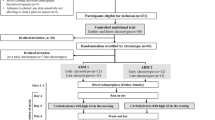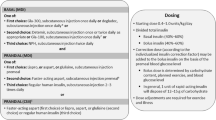Abstract
Objective:
This study evaluated gastric emptying (GE) and small intestinal (SI) transit in people with morbid obesity and their relationships to glycaemia, incretin hormones, and glucose absorption
Methods:
GE and caecal arrival time (CAT) of a mixed meal were assessed in 22 morbidly obese (50.2 ± 2.5 years; 13 F:9 M; BMI: 48.6 ± 1.8 kg/m2) and 10 lean (38.6 ± 8.4 years; 5 F:5 M; BMI: 23.9 ± 0.7 kg/m2) subjects, using scintigraphy. Blood glucose, plasma 3-O-methylglucose, insulin, glucagon, glucose-dependent insulinotropic polypeptide (GIP) and glucagon-like peptide-1 (GLP-1) were measured. Insulin sensitivity and resistance were also quantified
Results:
When compared with lean subjects, GE (t50: 60.7 ± 6.5 vs. 41.1 ± 7.3 min; P = 0.04) and CAT (221.5 ± 9.8 vs. 148.0 ± 7.1 min; P = 0.001) of solids were prolonged in morbid obesity. Postprandial rises in GIP (P = 0.001), insulin (P = 0.02), glucose (P = 0.03) and 3-O-methylglucose (P = 0.001) were less. Whereas GLP-1 increased at 45 mins post-prandially in lean subjects, there was no increase in the obese (P = 0.04). Both fasting (P = 0.045) and postprandial (P = 0.012) plasma glucagon concentrations were higher in the obese
Conclusions:
GE and SI transit are slower in the morbidly obese, and associated with reductions in postprandial glucose absorption, and glycaemic excursions, as well as plasma GIP and GLP-1




Similar content being viewed by others
References
Wright RA, Krinsky S, Fleeman C, Trujillo J, Teague E. Gastric emptying and obesity. Gastroenterology. 1983;84:747–51.
Tosetti C, et al. Gastric emptying of solids in morbid obesity. Int J Obes Relat Metab Disord. 1996;20:200–5.
Sasaki H, et al. Hyperinsulinemia in obesity: lack of relation to gastric emptying of glucose solution or to plasma somatostatin levels. Metabolism. 1983;32:701–5.
Barkin JS, Reiner DK, Goldberg RI, Phillips RS, Janowitz WR. The effects of morbid obesity and the Garren-Edwards gastric bubble on solid phase gastric emptying. Am J Gastroenterol. 1988;83:1364–7.
Verdich C, et al. Effect of obesity and major weight reduction on gastric emptying. Int J Obes Relat Metab Disord. 2000;24:899–905.
Collins PJ, Horowitz M, Cook DJ, Harding PE, Shearman DJ. Gastric emptying in normal subjects--a reproducible technique using a single scintillation camera and computer system. Gut. 1983;24:1117–25.
Horowitz M, Collins PJ, Harding PE, Shearman DJ. Gastric emptying after gastric bypass. Int J Obes. 1986;10:117–21.
Maddox A, Horowitz M, Wishart J, Collins P. Gastric and oesophageal emptying in obesity. Scand J Gastroenterol. 1989;24:593–8.
Jackson SJ, et al. Delayed gastric emptying in the obese: an assessment using the non-invasive (13)C-octanoic acid breath test. Diabetes Obes Metab. 2004;6:264–70.
Wisen O, Hellstrom PM. Gastrointestinal motility in obesity. J Intern Med. 1995;237:411–8.
Wisen O, Johansson C. Gastrointestinal function in obesity: motility, secretion, and absorption following a liquid test meal. Metabolism. 1992;41:390–5.
Mushref MA, Srinivasan S. Effect of high fat-diet and obesity on gastrointestinal motility. Ann Transl Med. 2013;1:14.
le Roux CW, Bueter M. The physiology of altered eating behaviour after Roux-en-Y gastric bypass. Exp Physiol. 2014;99:1128–32.
le Roux CW, et al. Gut hormones as mediators of appetite and weight loss after Roux-en-Y gastric bypass. Ann Surg. 2007;246:780–5.
Nguyen NQ, et al. Accelerated intestinal glucose absorption in morbidly obese humans: relationship to glucose transporters, incretin hormones, and glycemia. J Clin Endocrinol Metab. 2015;100:968–76.
Goy YM, Toumi Z, Date RS. Surgical cure for type 2 diabetes by foregut or hindgut operations: a myth or reality? A systematic review. Surg Endosc. 2017;31:25–37.
Mingrone G, Castagneto-Gissey L. Mechanisms of early improvement/resolution of type 2 diabetes after bariatric surgery. Diabetes Metab. 2009;35:518–23.
Spector D, Shikora S. Neuro-modulation and bariatric surgery for type 2 diabetes mellitus. Int J Clin Pract Suppl. 2010;166:53–8.
Kwon Y, et al. The foregut theory as a possible mechanism of action for the remission of type 2 diabetes in low body mass index patients undergoing subtotal gastrectomy for gastric cancer. Surg Obes Relat Dis. 2014;10:235–42.
O’Doherty M, Day A. Glycated haemoglobin and diagnosis of diabetes mellitus: now well established but beware the pitfalls. Ann Clin Biochem. 2016;53:309–11.
Nguyen NQ, et al. Upregulation of intestinal glucose transporters after Roux-en-Y gastric bypass to prevent carbohydrate malabsorption. Obes (Silver Spring). 2014;22:2164–71.
Seimon RV, et al. Gastric emptying, mouth-to-cecum transit, and glycemic, insulin, incretin, and energy intake responses to a mixed-nutrient liquid in lean, overweight, and obese males. Am J Physiol Endocrinol Metab. 2013;304:E294–300.
Nguyen NQ, et al. Effects of fat and protein preloads on pouch emptying, intestinal transit, glycaemia, gut hormones, glucose absorption, blood pressure and gastrointestinal symptoms after Roux-en-Y gastric bypass. Obes Surg. 2016;26:77–84.
Nguyen NQ, et al. Effects of posture and meal volume on gastric emptying, intestinal transit, oral glucose tolerance, blood pressure and gastrointestinal symptoms after Roux-en-Y gastric bypass. Obes Surg. 2015;25:1392–400.
Dalla Man C, Caumo A, Cobelli C. The oral glucose minimal model: estimation of insulin sensitivity from a meal test. IEEE Trans Biomed Eng. 2002;49:419–29.
Dalla Man C, et al. Modeling hepatic insulin sensitivity during a meal: validation against the euglycemic hyperinsulinemic clamp. Am J Physiol Endocrinol Metab. 2013;304:E819–25.
Wolnerhanssen BK, et al. Gut hormone secretion, gastric emptying, and glycemic responses to erythritol and xylitol in lean and obese subjects. Am J Physiol Endocrinol Metab. 2016;310:E1053–61.
Andreazzi AE, et al. Impaired sympathoadrenal axis function contributes to enhanced insulin secretion in prediabetic obese rats. Exp Diabetes Res. 2011;2011:947917.
Kruszynska YT, Olefsky JM, Frias JP. Effect of obesity on susceptibility to fatty acid-induced peripheral tissue insulin resistance. Metabolism. 2003;52:233–8.
le Roux CW, et al. Gut hormone profiles following bariatric surgery favor an anorectic state, facilitate weight loss, and improve metabolic parameters. Ann Surg. 2006;243:108–14.
Faerch K, et al. GLP-1 response to oral glucose is reduced in prediabetes, screen-detected type 2 diabetes, and obesity and influenced by sex: the ADDITION-PRO Study. Diabetes. 2015;64:2513–25.
Cecil JE, Francis J, Read NW. Comparison of the effects of a high-fat and high-carbohydrate soup delivered orally and intragastrically on gastric emptying, appetite, and eating behaviour. Physiol Behav. 1999;67:299–306.
Wijlens AG, Erkner A, Mars M, de Graaf C. Longer oral exposure with modified sham feeding does not slow down gastric emptying of low- and high-energy-dense gastric loads in healthy young men. J Nutr. 2015;145:365–71.
Corvilain B, et al. Effect of short-term starvation on gastric emptying in humans: relationship to oral glucose tolerance. Am J Physiol. 1995;269:G512–7.
Kentish SJ, Ratcliff K, Li H, Wittert GA, Page AJ. High fat diet induced changes in gastric vagal afferent response to adiponectin. Physiol Behav. 2015;152:354–62.
Kentish SJ, Vincent AD, Kennaway DJ, Wittert GA, Page AJ. High-fat diet-induced obesity ablates gastric vagal afferent circadian rhythms. J Neurosci. 2016;36:3199–207.
Lavigne ME, Wiley ZD, Meyer JH, Martin P, MacGregor IL. Gastric emptying rates of solid food in relation to body size. Gastroenterology. 1978;74:1258–60.
Meyer-Gerspach AC, et al. Gastric and intestinal satiation in obese and normal weight healthy people. Physiol Behav. 2014;129:265–71.
van der Klaauw AA, et al. High protein intake stimulates postprandial GLP-1 and PYY release. Obes (Silver Spring). 2013;21:1602–7.
Acosta A, et al. Quantitative gastrointestinal and psychological traits associated with obesity and response to weight-loss therapy. Gastroenterology. 2015;148:537–46.
Adam TC, Jocken J, Westerterp-Plantenga MS. Decreased glucagon-like peptide 1 release after weight loss in overweight/obese subjects. Obes Res. 2005;13:710–6.
Heden TD, et al. Liquid meal composition, postprandial satiety hormones, and perceived appetite and satiety in obese women during acute caloric restriction. Eur J Endocrinol. 2013;168:593–600.
Ranganath LR, et al. Attenuated GLP-1 secretion in obesity: cause or consequence? Gut. 1996;38:916–9.
Verdich C, et al. The role of postprandial releases of insulin and incretin hormones in meal-induced satiety--effect of obesity and weight reduction. Int J Obes Relat Metab Disord. 2001;25:1206–14.
Reaven GM, Chen YD, Golay A, Swislocki AL, Jaspan JB. Documentation of hyperglucagonemia throughout the day in nonobese and obese patients with noninsulin- dependent diabetes mellitus. J Clin Endocrinol Metab. 1987;64:106–10.
Kozawa J, et al. Early postprandial glucagon surge affects postprandial glucose levels in obese and non-obese patients with type 2 diabetes. Endocr J. 2013;60:813–8.
Henkel E, Menschikowski M, Koehler C, Leonhardt W, Hanefeld M. Impact of glucagon response on postprandial hyperglycemia in men with impaired glucose tolerance and type 2 diabetes mellitus. Metabolism. 2005;54:1168–73.
Ranganath LR, Beety JM, Morgan LM. Inhibition of insulin, glucose-dependent insulinotropic polypeptide (GIP) and glucagon-like peptide-1 (GLP-1) secretion by octreotide has no effect on post-heparin plasma lipoprotein lipase activity. Horm Metab Res. 1999;31:262–6.
Gu W, et al. Glucagon receptor antagonist-mediated improvements in glycemic control are dependent on functional pancreatic GLP-1 receptor. Am J Physiol Endocrinol Metab. 2010;299:E624–32.
Kazierad DJ, et al. Effects of multiple ascending doses of the glucagon receptor antagonist PF-06291874 in patients with type 2 diabetes mellitus. Diabetes Obes Metab. 2016;18:795–802.
Bennink R, et al. Comparison of total and compartmental gastric emptying and antral motility between healthy men and women. Eur J Nucl Med. 1998;25:1293–9.
Bennink R, et al. Evaluation of small-bowel transit for solid and liquid test meal in healthy men and women. Eur J Nucl Med. 1999;26:1560–6.
Madsen JL, Graff J. Effects of ageing on gastrointestinal motor function. Age Ageing. 2004;33:154–9.
Author information
Authors and Affiliations
Corresponding author
Ethics declarations
Conflict of interest
The authors declare that they have no conflict of interest.
Rights and permissions
About this article
Cite this article
Nguyen, N.Q., Debreceni, T.L., Burgess, J.E. et al. Impact of gastric emptying and small intestinal transit on blood glucose, intestinal hormones, glucose absorption in the morbidly obese. Int J Obes 42, 1556–1564 (2018). https://doi.org/10.1038/s41366-018-0012-6
Received:
Revised:
Accepted:
Published:
Issue Date:
DOI: https://doi.org/10.1038/s41366-018-0012-6
- Springer Nature Limited




